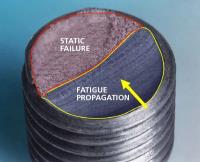 Add My Company
Add My Company
Sign In
Improving Fatigue Resistance
01-02-2019

A: The fatigue capacity of a bolted joint is very small, as compared to its static capacity. To improve fatigue resistance, designers can increase the thread capacity and decrease the alternating stresses at the threads.
To increase the thread capacity, it is recommended to use a rolled thread instead of a cutting process. To increase the bolted joint capacity, utilize multiple smaller fasteners instead of a single larger fastener.
The capacity is also increased by using an improved connector, such as a Superbolt MJT (Multi-Jackbolt Tensioner) or Flexnut, which improves the load distribution in the threads and adds elasticity to the bolted joint.
The best way to improve fatigue resistance is to reduce the alternating stresses at the threads. There are three main ways of doing this: Assembly design, assembly tightening, and assembly security.
The assembly design process provides an opportunity for improvement of the load distribution on bolted joints and to reduce the level of external stresses supported by each joint. To facilitate that, keep these principals in mind:
Use the highest possible preload
Minimize the bolt to load eccentricity
Use the largest possible contact surfaces
Use the largest possible clamping lengths
In most cases, use a preload higher than the working load
Other assembly design options include the use of necked-down studs or bolts, and the use of elastic washers, which counter the effects of relaxation, creeping, and thermal differential elongation.
With regard to assembly tightening, achieving the necessary preload is the main factor in reducing alternating stresses. It is recommended to use calibrated tools with high accuracy. It is also recommended to use a proper lubricant to achieve preload accuracy, and to reduce the risk of seizing. A suitable tightening sequence should be used to mitigate the risk of un-evenly loaded bolts and to ensure overall bolted joint integrity.
Regarding assembly security, it is recommended to secure the bolted joint against loss of preload. Further, secure the assembly against environmental effects, such as corrosion that could initiate a fatigue crack. This may be done through the selection of suitable materials and/or coatings for parts and fasteners.
For more information on Improving Fatigue Resistance talk to Nord Lock Ltd
Enquire Now
List your company on FindTheNeedle.
